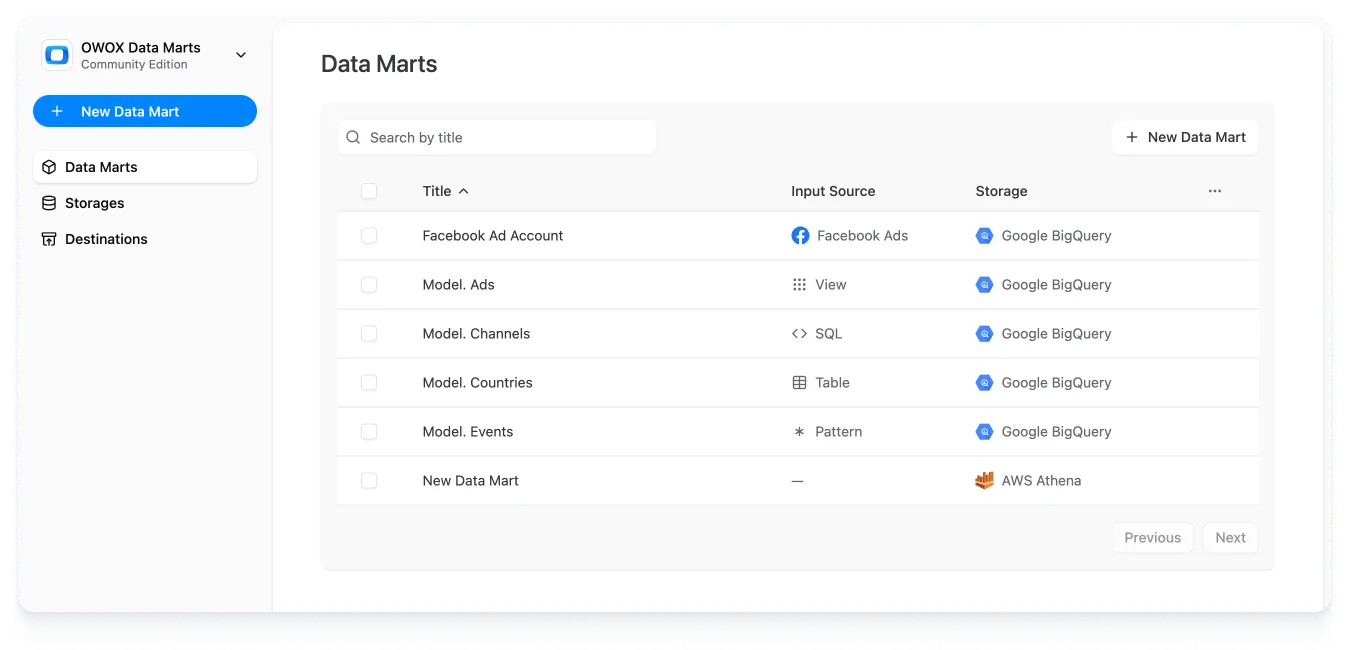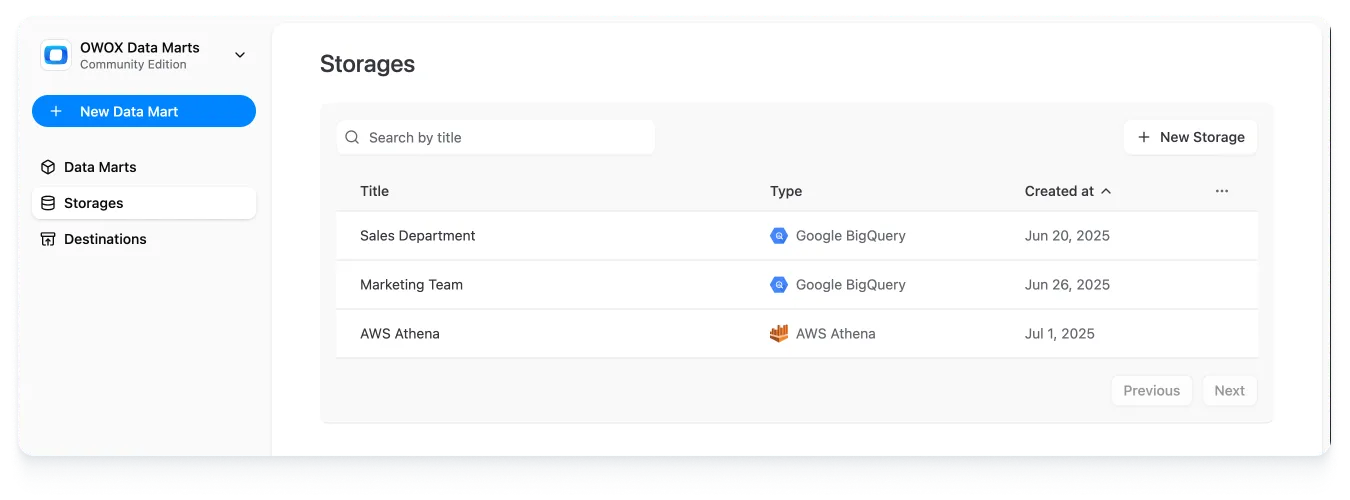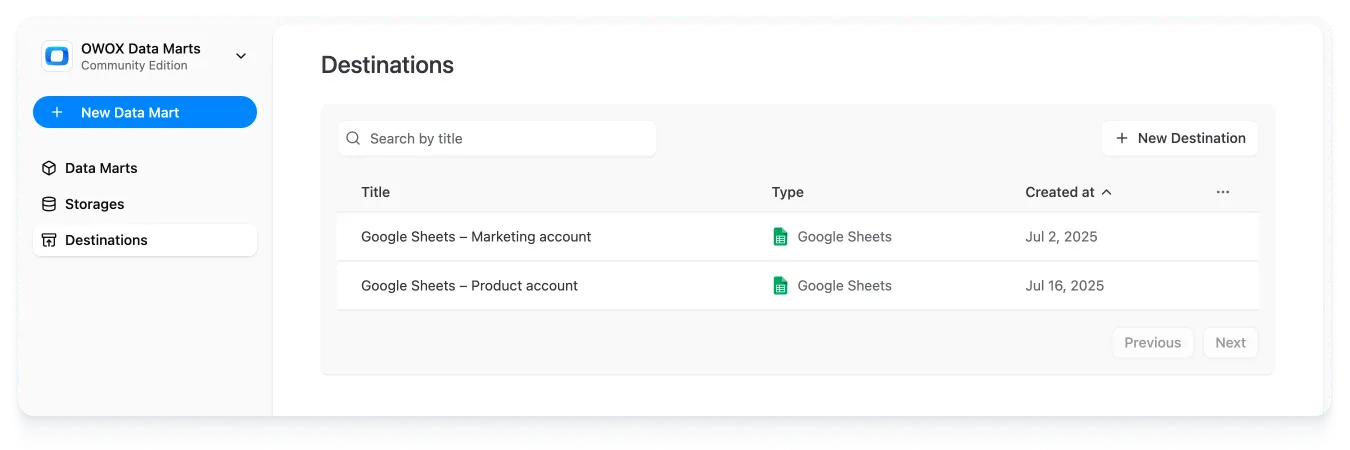Core Concepts
Welcome to OWOX Data Marts – a structured, controlled, and reliable way to control, organize, and share business-ready data from data teams to business users. The OWOX team, with over 20 years of experience developing data products, stays on 3 core beliefs:
- Control over reporting for data analysts
- Freedom for business users to timely access data
- Trusted data for across reports & dashboards
This guide will help you better understand our beliefs, values & save time during implementation.
Entities
Section titled “Entities”OWOX Data Marts has a lot of terms inside, but here are the basic ones:
- Data Mart is a set of meaningful data controlled by data analyst and used by business users for reporting (directly or indirectly).
- Source is a platform like Meta Ads or TikTok Ads, Reddit Ads, from which raw data is collected via connectors.
- Storage is a data warehouse (e.g., Google BigQuery, AWS Athena) where all data is stored & processed.
- Destination is a BI tool where business users access data (e.g., Google Sheets, Looker Studio).
- Report is a specific spreadsheet tab where data is exported to.
- Trigger rules for automated data delivery on a schedule.
- Run is a single manual or an automated data load action.
Data Mart
Section titled “Data Mart”
An OWOX Data Mart is the foundational entity in OWOX Data Marts. It’s a controlled, ready-to-share artifact designed for analytics and reporting.
It’s crafted by data analysts and can be defined using:
and handed off to business users so they can run, filter, and schedule reports – without breaking YOUR logic and asking for help, pinging in Slack, or creating another JIRA ticket.
Unlike raw data inside your data warehouse, each Data Mart is:
- Documented with a description, business outcome, and output schema with friendly metric names
- Reusable across BI tools: Google Sheets, Looker Studio, Excel, and more
- Trustworthy - no more asking “Whose report is right?”
- Modeled (optional) by setting up relationships with other data marts
☝️ Think of it as a source of truth for a specific business question, like:
- “How did our customer acquisition cost change over time?”
- “What’s our ROAS by campaign and channel?”
- “Which features drive subscription renewals?”
Connector-defined Data Marts import data from external Sources (e.g., Facebook Ads, Google Sheets) into a Storage. All other types of Data Marts query data directly from the Storage.
☝️ Data Marts empower Data Analysts to control and hand off business-ready data.
Source
Section titled “Source”Source is a service that holds data you want to manipulate—for example, Facebook Ads, TikTok Ads, Google Analytics, Salesforce, Google Sheets, etc. You can find the available connectors here.
☝️ By managing a Data Mart’s Sources, a Data Analyst controls the origin of the data.
Storage
Section titled “Storage”
Storage is your project’s data warehouse (DWH) — a SQL-compatible system where all your data lives, such as:
- Google BigQuery
- AWS Athena
- Databricks
- Snowflake
- etc
Each project must have at least one Storage, which stores and processes all your data. You can configure multiple Storages, but each Data Mart must be linked to exactly one.
☝️ By specifying a Data Mart’s Storage, a Data Analyst ensures data ownership and controls where the data is stored and processed.
Destination
Section titled “Destination”
A Destination is an interface or application used by business users to access the data. Supported destinations include:
- Google Sheets
- Looker Studio
- OData (compatible with Excel, Tableau, Power BI, etc)
Each Data Mart can be linked to multiple Destinations.
- All destinations except Google Sheets operate in pull mode — they query Storage when a user or tool requests the data.
- Google Sheets uses push mode — data is exported from the Data Mart into a Report in Google Sheets via manual or scheduled runs.
☝️ Destinations allow Data Analysts to control and monitor which services business users consume data in.
Report
Section titled “Report”A Report defines a specific sheet within a Google Sheets document where the Data Mart’s data is exported. Different Google Sheets Reports of the same Data Mart may have different scheduled triggers.
Trigger
Section titled “Trigger”Triggers automate data movement on a schedule. There are 2 types of triggers in OWOX Data Marts:
☝️ Triggers allow Data Analysts to control data freshness and save time.
Run Types
Section titled “Run Types”- Connector Run – import data from a Source into Storage.
- Report Runs – push or pull data (stored in Storage) to a Destination.